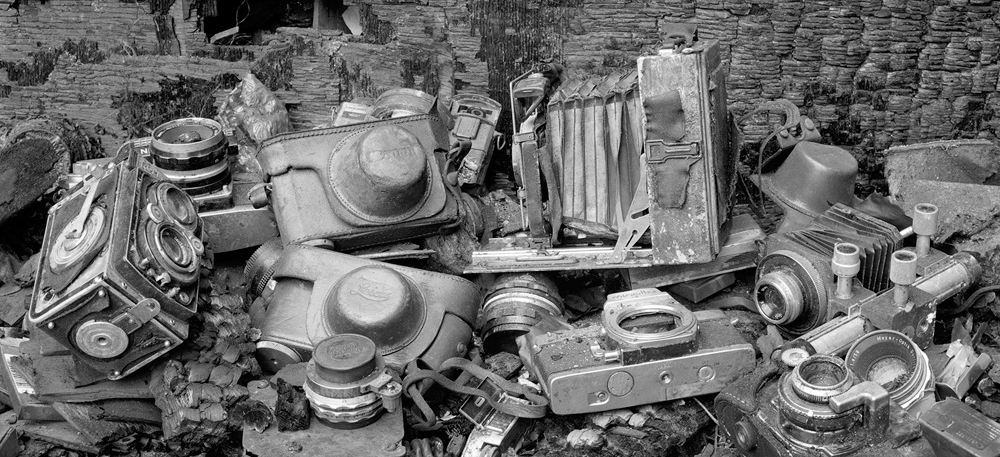The Hamster Wheel of Progress
by Huntington Witherill, 2004
In outright theft of a line from the great comedian, Dennis Miller..."I don't want to get off on a rant here, but..."
As digital technology continues to work its magic on increasing legions of photographers – many of whom appear to be getting sore ankles as a result of jumping for joy at the nearly overwhelming array of creative possibilities inherent the digital approach – now might be a good time to step back and survey the possible long-term rewards (or dare I suggest... consequences) of climbing aboard the hamster wheel of progress.
As a fine art photographer who was trained nearly thirty-five years ago in what might best be described as a "classical" approach to the medium (black and white, view camera, the Zone System... the "West Coast School") I have, over the past ten to twelve years, admittedly fallen hook, line, and sinker for the promises of digital photography. And to be honest many of those promises have been fulfilled, in spades. I, too, am getting sore ankles. Though in my own case the affliction is likely the result of dragging my heels in a hopeless attempt to constrain the hamster wheel, itself, and less so the act of jumping for joy.
Using digital technology to produce photographs as a means of achieving personal and artistic self-expression is not all that different from using the more conventional tools – provided one is focused on the goal, itself, rather than being focused on the specific tools and materials used to achieve that goal. Of course, the goal I'm referring to, here, is one of producing "successful" photographs on a consistent and ongoing basis. On that basis, successful photographs can only be accomplished by applying creativity and imagination to the complete mastery of one's chosen tools and materials. Simply put, if you don't intimately know the technical and expressive capabilities and nuances of your tools, and know precisely how to get those tools to perform to your will, you'll likely never achieve successful photographs on a consistent basis. And, this will be true regardless the specific kinds of tools you choose to use.
I often like to describe photographs as being two-dimensional stylized interpretations of a given reality that are (in the final analysis) a direct result of the photographer's decision-making process. Of course, the specifics of one’s decision-making will be (not inconsequentially) guided by whatever set of tools and materials the photographer chooses to use. However, the success of a given photograph has little (if anything) to do with what specific tools and materials are being employed to produce the photograph, itself. It is the human decision making process that dictates the result, and not the tools and materials. Thus, whether one chooses to employ conventional or digital tools makes little difference in terms of the relative success or failure of a given photographic expression. Trust me, it's really all about the decision making process.
In this discussion, the goal of achieving a successful photographic expression also involves the ability to ultimately communicate messages of substance (and hopefully, of consequence) to an audience through means of a visual medium. Achieving clear, precise, and effective visual communication – using a camera – requires the application of creativity, imagination, and forethought, together with sound and focused decision-making. By applying the aforementioned attributes, the photographer is able to manipulate (in a calculated, intentional, and practiced manner) a chosen set of tools and materials so as to reliably achieve a predictable outcome that can serve as a truly effective means of communication. And not to put too fine a point on it, doing so on a regular basis requires the complete mastery of both the technical and expressive capabilities - the practiced implementation - of one's chosen tools and materials. Let's face it, you can't concentrate your effort on applying imagination and creativity to your photography while you're continually fumbling about to locate the proper controls on your camera that will allow you to dial-in a proper exposure. And, therein lies the rub.
Conventional approaches to photography have remained virtually unchanged over the past 100 years. A view camera, film, and an enlarger work essentially the same as they always have. The skill with which one can apply imagination and creativity through the use of these tools remains relatively predictable and reasonably controlled once the initial learning curve has been negotiated. And, these tools will remain comparatively consistent in terms of their design, implementation, and compatibility, from year to year – so that when they finally do break down, they can be replaced with essentially the same exact tool. However, digital tools and materials continue to reinvent themselves with the frequency of high fashion hemlines! Acquiring and subsequently maintaining control and familiarity with digital tools and materials remains a particularly elusive, redundant, and time-consuming task. An interesting and informative task to be sure, but not one that is necessarily conducive to the actual production of art.
Charlie Parker was arguably one of the greatest jazz saxophonists of all time. Yet, I wonder if he could possibly have become such an accomplished musician, were he to have been compelled to re-learn a "new and improved" fingering scheme (fill in the latest version number here) on his horn every eighteen months. Parker knew his instrument cold. He didn't have to think about how to get the specific sound he wanted from his horn because he instinctively knew how to get it. He had repeated the exercise so many times with the same instrument that it simply became second nature. He didn't have to continually pay attention to the mechanics of his tools. He had only to deal with his own creativity, experience, and decision making in order to accomplish an enduring legacy of musical expression.
In my view, the use of digital technology, while having the ability to exponentially expand the possibilities for new and refreshing photographic visualization and manifestation, will nevertheless continue to impede and frustrate its practitioners by nature of the fact that once you've climbed aboard the digital hamster wheel, you either commit to spending significant amounts of time repetitively re-learning the basic nuances of your tools as they incessantly change, or you do as I have and attempt (with predictably diminishing success) to ignore all the upgrade paths and stick with the tools you know. I currently use a Macintosh G4, with System 9.2.2, and Photoshop, version 6.0.1. Those tools are now up to five years old. In digital terms, that means they’re virtual dinosaurs. I figure my current tools and materials to be serviceable for another 2-3 years before they are completely unusable as having become virtually incompatible with any then current standard. The writing is on the wall. Manufacturers simply do not support, nor encourage backwards compatibility. Planned obsolescence will not be so easily deterred.
When my current computer system goes belly up (and it will, just like the past three have) I'll be forced to upgrade and it'll be back to square one. New computer, new operating system (there's at least a month's worth of re-education, right there!) new software, new peripherals, new storage devices, and maybe even a new "super gigapixel" camera, by then. All of it will be thoroughly "new and improved", and every bit of it... absolutely unfamiliar. And, let's not even mention the monetary costs associated with this boatload of gear. Once again, I'll be faced with re-learning the mechanical implementation and expressive nuances of most all of my tools. As a photographer who will soon become eligible to join the AARP, this seems a decidedly redundant and wasteful use of precious time. Time that none of us have in great abundance.
Will digital photography technologies ever come to a place of design standardization like a trusted view camera, or enlarger? I seriously doubt it. In my view digital photography is a lot like youth. Illusions of eternity are all too quickly overwhelmed by the reality of lost opportunity. To me, the rewards of digital photography are not unlike that $100 bill tacked to the top of a greased flagpole. The prize remains an enticing one. Yet, the odds that I'll get within arm's reach of the top, only to slide back down empty-handed, seem nearly overwhelming.
Digital photography has a lot going for it. And the superior aesthetic potential inherent the medium will likely continue to trump these pesky "new and improved" issues. Personally, I plan to continue my relentless drive to scamper up that flagpole, regardless the costs. Yet, in my opinion, the digital path will also continue to offer a reasonably frustrating and difficult approach to fine art photography. Achieving any sort of enduring mastery over such a relentlessly evolving set of ultimately incompatible tools and materials is likely to remain a decidedly mercurial pursuit.
"Of course, that's just my opinion... I could be wrong."
[This article originally appeared in PSA Journal, published by the Photographic Society of America, 2004.]
Please Note- A freely downloadable PDF version of this article can be found on the Downloads page.

